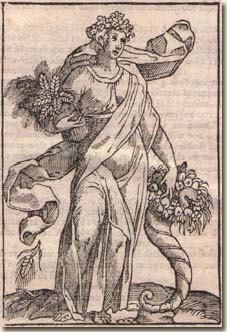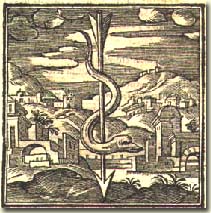The fifth volume of the authoritative Diccionario de los Autoridades (1737), in the entry “Prodigaleza,” instead of giving a definition of prodigality, only says “voz antiquada,” and refers us to the modern form “Prodigalidad.” Nevertheless, it illustrates the use of this term with a stanza taken from Cristóbal de Castillejo:
Es la liberal franqueza
medida distribución,
entre la prodigaléza
y escaséza
del aváro corazón.
(The liberal magnificence / is the middle course / between prodigality / and the meagreness / of the avaricious heart.)
And this quotation suddenly gives us the key to the interpretation of a painting conserved in the Pinacoteca Tosio-Martinengo of Brescia (Inv. no. 291 – thanks for the reference to Sοnja Lucas!)
This composition is an authentic work of Cavaliere d’Arpino, supposed illustrator of Cesare Ripa’s Iconologia (1603) the authoritative lexicon of symbols of the Renaissance. No wonder, then, that they tried to identify it as an “Allegoria dell’Abbondanza” – this is how it actually figures in the catalog – on the basis of the allegory “Abbodanza” of Ripa that carries a cornucopia in one hand, and scatters ears of corn with the other. But this interpretation gives no explanation for the other two figures that do not figure in the entry “Abbondanza” of the Iconologia by Cesare Ripa.
tried to identify it as an “Allegoria dell’Abbondanza” – this is how it actually figures in the catalog – on the basis of the allegory “Abbodanza” of Ripa that carries a cornucopia in one hand, and scatters ears of corn with the other. But this interpretation gives no explanation for the other two figures that do not figure in the entry “Abbondanza” of the Iconologia by Cesare Ripa.
However, in Ripa there is another figure carrying a cornucopia as well: the allegory of “Liberalità”. What’s more, this allegorical figure also carries an eagle on her head – this bird is namely the most liberal amongst all, according to Pliny, because it always abundantly leaves of its prey to the other birds –, just like the protagonist in our painting, making the identification even more unambigous. And the text of the entry characterizes her like this:
just like the protagonist in our painting, making the identification even more unambigous. And the text of the entry characterizes her like this:
“La Liberalità è vna mediocrità nello spendere per habito virtuoso, & moderato.”
(The Liberality is a golden mean conserved in spending by the virtuous and tempered character.)
This definition that tallies so well with that of Cristóbal de Castillejo, offers a perfect explanation for the two other figures, that are therefore obviously meagre Avarice – keeping her coffer and a disgusting toad, as she figures in Ripa –, and lavishly dressed Prodigality – with her hunting dog, falcon and pack of cards –, respectively.
However, we should not believe that this definition given by Ripa and depicted by Cavaliere d’Arpino derives from Castillejo. No: all the three are debtors to a much older source, the Nicomachean Ethics of Aristotle. In this most influential catalog of virtues and vices that determined European thought for two millennia, virtues are always characterized as the golden mean between the opposite poles of two vices, one of which is the “defect” of the respective virtue, while the other is an “excess” of it. Here, in the chapter about “virtues connected with money” we read about liberality and its opposites:
“Liberality ... seems to be the mean with regard to wealth ... Prodigality and meanness are excesses and defects with regard to wealth; and meanness we always impute to those who care more than they ought for wealth ... and we call those men prodigals who are incontinent and spend money on self-indulgence.”
How advised is this view, where a virtue has not only one contrary, but two, that, while both are a deviation from the “golden mean”, are also opposed to each other. This is the view that is so concisely illustrated by the famous emblem “Maturandum” of Alciato, explaining the renowned symbol in the “coat of arms” of Emperor Agustus. As it was translated into Spanish by Bernardino Daza Pinciano in 1549:
Es la liberal franqueza
medida distribución,
entre la prodigaléza
y escaséza
del aváro corazón.
(The liberal magnificence / is the middle course / between prodigality / and the meagreness / of the avaricious heart.)
And this quotation suddenly gives us the key to the interpretation of a painting conserved in the Pinacoteca Tosio-Martinengo of Brescia (Inv. no. 291 – thanks for the reference to Sοnja Lucas!)
This composition is an authentic work of Cavaliere d’Arpino, supposed illustrator of Cesare Ripa’s Iconologia (1603) the authoritative lexicon of symbols of the Renaissance. No wonder, then, that they
 tried to identify it as an “Allegoria dell’Abbondanza” – this is how it actually figures in the catalog – on the basis of the allegory “Abbodanza” of Ripa that carries a cornucopia in one hand, and scatters ears of corn with the other. But this interpretation gives no explanation for the other two figures that do not figure in the entry “Abbondanza” of the Iconologia by Cesare Ripa.
tried to identify it as an “Allegoria dell’Abbondanza” – this is how it actually figures in the catalog – on the basis of the allegory “Abbodanza” of Ripa that carries a cornucopia in one hand, and scatters ears of corn with the other. But this interpretation gives no explanation for the other two figures that do not figure in the entry “Abbondanza” of the Iconologia by Cesare Ripa.However, in Ripa there is another figure carrying a cornucopia as well: the allegory of “Liberalità”. What’s more, this allegorical figure also carries an eagle on her head – this bird is namely the most liberal amongst all, according to Pliny, because it always abundantly leaves of its prey to the other birds –,
 just like the protagonist in our painting, making the identification even more unambigous. And the text of the entry characterizes her like this:
just like the protagonist in our painting, making the identification even more unambigous. And the text of the entry characterizes her like this:“La Liberalità è vna mediocrità nello spendere per habito virtuoso, & moderato.”
(The Liberality is a golden mean conserved in spending by the virtuous and tempered character.)
This definition that tallies so well with that of Cristóbal de Castillejo, offers a perfect explanation for the two other figures, that are therefore obviously meagre Avarice – keeping her coffer and a disgusting toad, as she figures in Ripa –, and lavishly dressed Prodigality – with her hunting dog, falcon and pack of cards –, respectively.
However, we should not believe that this definition given by Ripa and depicted by Cavaliere d’Arpino derives from Castillejo. No: all the three are debtors to a much older source, the Nicomachean Ethics of Aristotle. In this most influential catalog of virtues and vices that determined European thought for two millennia, virtues are always characterized as the golden mean between the opposite poles of two vices, one of which is the “defect” of the respective virtue, while the other is an “excess” of it. Here, in the chapter about “virtues connected with money” we read about liberality and its opposites:
“Liberality ... seems to be the mean with regard to wealth ... Prodigality and meanness are excesses and defects with regard to wealth; and meanness we always impute to those who care more than they ought for wealth ... and we call those men prodigals who are incontinent and spend money on self-indulgence.”
How advised is this view, where a virtue has not only one contrary, but two, that, while both are a deviation from the “golden mean”, are also opposed to each other. This is the view that is so concisely illustrated by the famous emblem “Maturandum” of Alciato, explaining the renowned symbol in the “coat of arms” of Emperor Agustus. As it was translated into Spanish by Bernardino Daza Pinciano in 1549:



